Overview of the process & principles
As an IEEE conference proceedings, all practices are aligned with IEEE Policies as well as the IEEE PSPB Operations Manual.
The IEEE Signal Processing Society holds an open call to the community that is listed on the conference website as well as emails to members and past participants, and posted to Call for Paper Online Message Boards to encourage an open and transparent submission and review process.
The Call for Papers, created by the Technical Program Committee Chairs (Editors), conveys relevant author information and paper requirements, important dates, and a non-exhaustive list of topic areas, called EDICS, which are considered in scope.
Paper submission deadlines are set for Wednesdays, including extensions along with other deadlines as much as possible. Moreover, paper submission deadlines are scheduled to avoid Major World Holidays. This aims to ensure that all members of the community participate by limiting the strain on authors and respecting individual’s personal, family, and home time.
Peer-reviewing is of vital importance to ensure the scientific quality of conference papers, and all papers submitted receive transparent, unprejudiced, efficient, and anonymous peer review, which is carried out by the Technical Program Committee—a well-defined hierarchy structure which includes the Technical Program Committee Chairs and Organizing Committee Members, and the IEEE Signal Processing Society Technical Committee Chairs and Committee Members–which oversees a large group of dedicated reviewers.
The editorial process of a paper consists of two parts: an initial check and then peer review. The paper is sent to a track chair for an initial check. Following this, the paper is assigned to at least three reviewers from the relevant research areas for peer review. These reviewers carefully review the manuscript and provide review comments to the area chair. Authors have an option to submit a rebuttal to the comments. The review comments and authors’ rebuttals, if any, will help the track chair to make the ultimate acceptance or rejection recommendation for the manuscript.
During the editorial process, the conference’s publication provider takes the responsibility of coordination between the publisher and authors, copyediting work, and other necessary publication support.
An Ombud is assigned for each conference and any violations of policies should be reported to the conference ombud, noted on the Organizing Committee page. All reports will be treated confidentially. The Ombud will investigate and prepare a brief statement of facts, a conclusion (proven/not proven) using a preponderance of the evidence standard, and a recommended sanction if a violation is proven. The Conference Organizing Committee will vote to either adopt or not adopt this recommendation and may modify it. The decision of the Committee is final.

